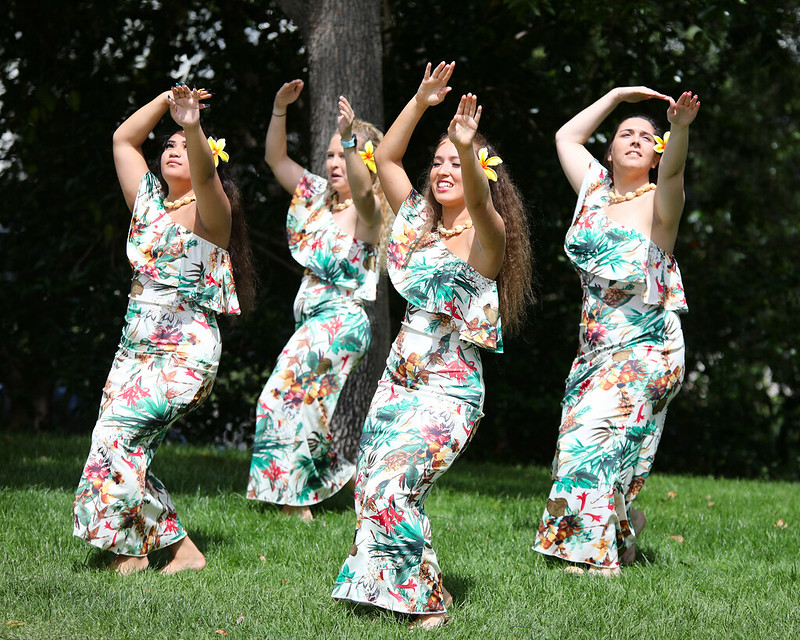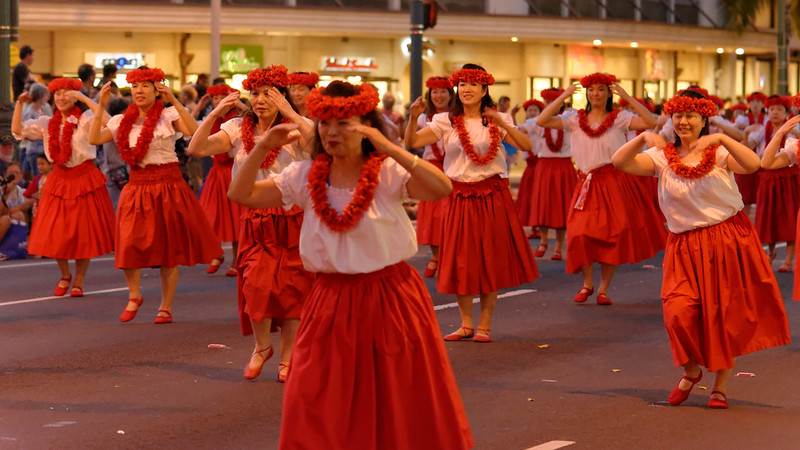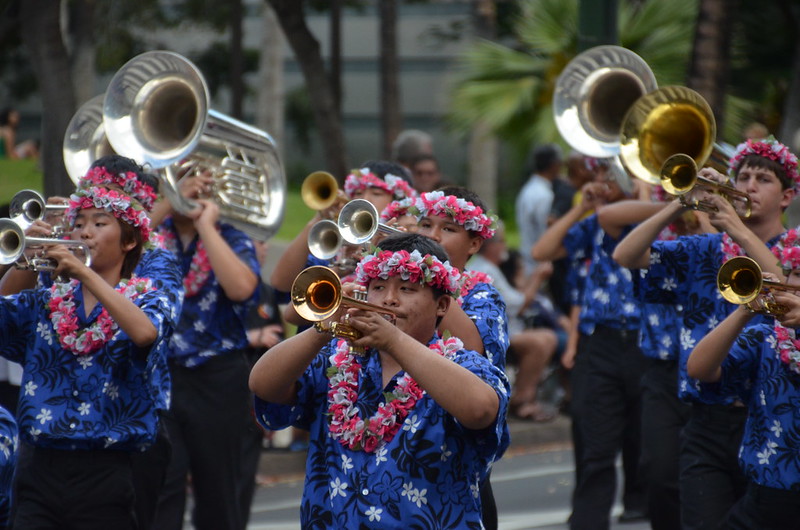Aloha Festivals
A Vibrant Tapestry of Hawaiian Culture
2026/08/31 - 2026/09/29
Every September, the Hawaiian Islands come alive with the Aloha Festivals. This month-long celebration honors Hawaiian culture and music, attracting over 100,000 participants each year, primarily on the island of Oahu. The colorful Floral Parade winding through Waikiki features traditional hula dancing and the sounds of ukuleles. Additionally, the Waikiki Ho'olaule'a offers modern Jawaiian music, providing a valuable opportunity to immerse oneself in Hawaii's rich cultural heritage.
Main Attractions
Royal Court Investiture
The festival opens with the majestic Royal Court Investiture held at Helumoa in Waikiki. Ali'i (royalty) don vibrant feather capes and helmets, their colors shimmering in the sunlight as the coronation ceremony takes place. The air fills with the mystical sounds of conch shells and traditional oli (chants), transporting spectators to ancient Hawaii. This ceremony, filled with ritual and splendor, sets the tone for the cultural journey ahead.
Waikiki Ho'olaule'a
Waikiki Ho'olaule'a is one of the most popular events in the Aloha Festivals, where "Ho'olaule'a" means "celebration" in Hawaiian. Every September, Kalakaua Avenue transforms into Hawaii's largest outdoor party venue. Approximately 30,000 people gather for this event to experience a night filled with Hawaiian music history. From traditional mele (Hawaiian songs) to the sounds of ukuleles and steel guitars, as well as contemporary Jawaiian music (Hawaiian reggae), a variety of musical genres can be enjoyed. Live performances of famous songs like "My Little Grass Shack" and "Lovely Hula Hands" fill the air, while spontaneous hula dancing unfolds throughout the street. Food stalls offer Hawaiian dishes like kalua pork and fresh pineapple, alongside displays of crafts such as koa wood carvings and shell leis, making it a grand event to engage all five senses.
Floral Parade
The grand finale of the Aloha Festivals is the breathtaking Floral Parade. Starting from Ala Moana Beach Park and winding through Waikiki, this spectacular procession features intricately decorated floats adorned with thousands of tropical flowers, filling the air with their sweet fragrance. A highlight is the pa'u riders, women on horseback dressed in flowing gowns representing each Hawaiian island, riding horses adorned with leis. Marching bands and hula halau (hula schools) enhance the festive atmosphere, creating a feast for both the eyes and ears.
Cultural and Historical Background
The Aloha Festivals began in 1946 as "Aloha Week." In the post-World War II era, it was conceived by former Junior Chamber of Commerce members to celebrate and preserve Hawaiian culture. Initially a one-week event held in mid-September, it was renamed "Aloha Festivals" in 1991 and has since grown into the largest Hawaiian cultural festival in the United States, celebrated throughout September. It attracts approximately 100,000 spectators each year, with an estimated economic impact exceeding $10 million.
For Hawaiians, the Aloha Festivals represent an important opportunity to preserve their cultural identity. For example, during the festival's highlight event—the Royal Court ceremony—participants don costumes from Hawaii's monarchical era to reenact ancient traditions. Additionally, performances of hula kahiko (traditional hula) convey stories from Hawaiian mythology and history. Craft displays showcase traditional techniques like kapa (bark cloth) making and lei crafting, serving as a platform for passing down skills to younger generations. Furthermore, readings in Hawaiian language and performances of traditional instruments contribute to preserving Hawaii's language and music that are at risk of being lost. Thus, the Aloha Festivals play a crucial role not only in tourism but also in safeguarding and transmitting Hawaii's culture to future generations.
Participants Voices
I was overwhelmed by the Aloha Festivals as a visitor from the mainland. I came expecting beaches and luaus but experienced something much deeper instead. During Ho'olaule'a, I learned some basics of hula dancing. The patience and warmth of people embodied what I had heard about the spirit of aloha. By the end of the night, I found myself swaying alongside new friends who were once strangers; it felt like I had found a second home in Hawaii.
Fun Facts
- The Aloha Festivals are the only statewide cultural festival in the United States.
- Every year over 30,000 volunteers come together to make the Aloha Festivals possible.
- The Royal Court's feather capes (ahu'ula) can take years to create and are made from thousands of feathers from native Hawaiian birds.
- The festival's theme changes annually, highlighting different aspects of Hawaiian culture each year.
Festival Dates
The Aloha Festivals typically take place throughout September.
The event schedule is subject to change. Please check the official website for the most up-to-date information.
Information
| Name | Aloha Festivals |
| Country | United States |
| Area | Hawaii, Honolulu(Helumoa, The Royal Hawaiian’s Ocean Lawn) |
| Date | 2026/08/31 - 2026/09/29 |
| Link |
Upcoming Festivals
Whirling Dervishes Festival Turkey
A Mesmerizing Dance of Divine Love
2025/12/06Mevlana Celaleddin Rumi Commemoration Ceremony ( Şeb-i Arus ) Turkey
A Whirling Journey to Divine Love
2025/12/10Dia de la Virgen de Guadalupe Mexico
A Festival Weaving Faith, Fervor, and Mexican Identity
2025/12/11L'Escalade Switzerland
Geneva’s Grand Winter Festival of Courage, Chocolate, and Community
2025/12/12Umkhosi Wokweshwama South Africa
The Zulu First Fruits Festival—A Sacred Celebration of Land, Ancestors, and Renewal
2025/12/12Lucia Festival (St. Lucia's Day) Sweden
A Festival of Light Illuminating the Nordic Darkness
2025/12/15Las Posadas Mexico
The Luminous Quest for Sacred Shelter
2025/12/22Noche de Rabanos (Night of the Radishes) Mexico
A celebration blending art, farming heritage, and cultural traditions
2025/12/23Chant of the Sybil on Majorca Spain
A Medieval Prophecy Echoes Through Majorcan Christmas
2025/12/23‘Hatajo de Negritos’ and the ‘Hatajo de Pallitas’ Peru
A Christmas Festival of Rhythm, Faith, and Afro-Andean Heritage in Peru’s Ica Region


